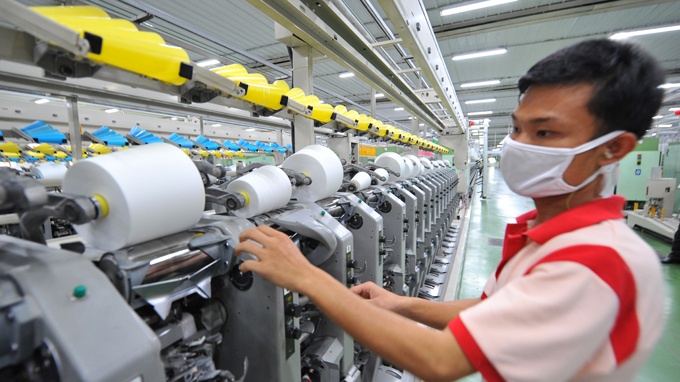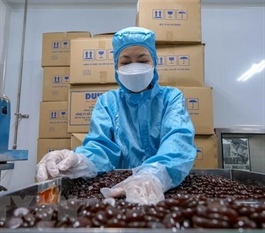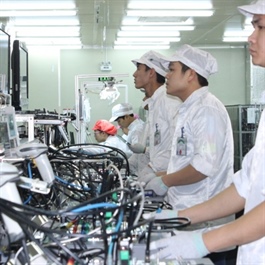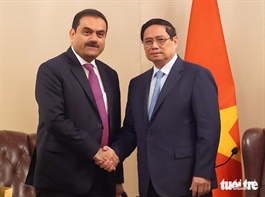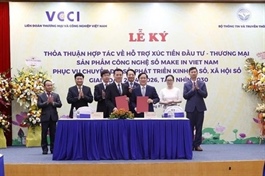Solving challenges critical to country's new semiconductor industry and market
Solving challenges critical to country's new semiconductor industry and market
The semiconductor industry is one of the most important strategic industries globally and Việt Nam is actively participating in the semiconductor ecosystem at both regional and global levels.
|
Visitors see a technology product at a booth at the Hanoi Semiconductor Festival 2024. — VNS Photos Trương Vị |
Việt Nam's strategic location and growing manufacturing capabilities make it an attractive destination for semiconductor companies looking to expand their global production footprint, with companies like Intel, Samsung, Foxconn, and Amkor investing in local factories.
The shift in global semiconductor production chains is opening up opportunities for Việt Nam to develop its domestic semiconductor industry.
Việt Nam has a young, educated workforce with a strong drive to innovate, which is well suited for the semiconductor industry.
The global semiconductor industry has seen remarkable growth in recent years, reaching nearly US$800 billion in value by 2023.
|
Visitors see a technology product at a booth during the Hanoi semiconductor investment festival 2024. — VNS Photos Trương Vị |
The rise of high-tech applications like self-driving cars, AI, cloud computing and big data are driving major demand growth for semiconductors, according to Dr. Vũ Xuân Hoài, Deputy Director of the National Innovation Centre.
Hoài told participants in a recent seminar focused on boosting investment and development in the industry that the semiconductor industry in Việt Nam is showing strong growth potential, with the participation of many leading global corporations like Samsung, Intel, Renesas, Qorvo, Marvell, Synopsys, Ampere and Infineon. These companies have established R&D centres and manufacturing plants in Việt Nam.
The Vietnamese government has shown strong determination in developing the semiconductor industry ecosystem, including establishing the National Innovation Center (NIC) and high-tech parks.
Việt Nam has implemented the National Power Development Plan and has transport infrastructure to support the semiconductor industry.
Preferential policy mechanisms like the Capital Law, Decree 94/2020/NĐ-CP and Resolution 98/2023/QH15 provide favourable conditions for investors.
Việt Nam has an abundant source of technical labour and many prestigious research and training units in the semiconductor field.
By 2030, Việt Nam aims to train a total of 50,000 engineers for the semiconductor industry, including 15,000 IC design engineers and 35,000 engineers for manufacturing, packaging, testing and other related fields. In addition, four national shared laboratories and 18 standard laboratories will also be established in the north, central and south of the country.
Việt Nam will support the semiconductor industry with 100 design enterprises, one manufacturing enterprise, ten chip packaging and testing enterprises and 15 semiconductor industrial equipment factories and expand the training network to about 200 locations nationwide.
The interest shown by US semiconductor giants such as Intel, Nvidia and others indicates strong international support and confidence in Việt Nam’s potential. Similarly, investments from South Korean, Taiwanese and Japanese companies underscore a broad-based interest in Việt Nam’s semiconductor ecosystem.
Recent high-level diplomatic and trade visits to Việt Nam by US President Biden and leading US, South Korean, Taiwanese, and Japanese semiconductor companies have highlighted Việt Nam's potential in this industry.
Trần Đình Thiên, former Director of the Vietnam Institute of Economics, also pointed out that Việt Nam, and Hà Nội in particular, are facing challenges in competing in the global semiconductor technology market.
The US has attracted US$395 billion in foreign investment in semiconductor production and announced $50 billion in funding for US companies for research, development and chip production.
Japan has invested over $30 billion for its companies to regain a leading position in the chip industry. China is also developing a new industrial ecosystem including AI and semiconductor chips.
|
Made in Vietnam IC boards are showcased at the Hanoi Semiconductor Investment Festival 2024 held in Hà Nội this week. — VNS Photos Trương Vị |
Over 15 years ago, Việt Nam has made some progress in the semiconductor industry. The country invested hundreds of millions of US dollars in key semiconductor technology laboratories.
The country also participated in the global semiconductor supply chain as an emerging manufacturer, assembler and tester, accounting for six per cent of semiconductor product value.
In 2022, Việt Nam exported $6.5 billion in semiconductor equipment, an 83 per cent increase from the previous year, making it a top three exporter in Asia. It has the potential to become an OSAT (Outsourced Semiconductor Assembly and Test) centre in Southeast Asia.
Challenges ahead
Despite the strengths, Việt Nam still faces some significant challenges that need to be overcome to fully capitalise on the semiconductor opportunity.
The semiconductor manufacturing process is incredibly complex and involves numerous steps. Each chip production cycle requires crossing international borders multiple times due to its fragmented supply chain. This complexity necessitates advanced technological expertise and high-level infrastructure, which Việt Nam currently lacks.
Việt Nam’s semiconductor industry is still in its nascent stages, with only a few local companies involved primarily in low-end chip design. Building a robust semiconductor ecosystem will require substantial investment in education and training to develop a skilled workforce capable of handling advanced technologies.
Developing semiconductor manufacturing capabilities requires significant infrastructure, including clean rooms, advanced fabrication facilities, and reliable supply chains. Việt Nam will need to make substantial investments to build and maintain such infrastructure.
Developing a robust semiconductor ecosystem requires major investments in R&D, specialised talent development, advanced manufacturing capabilities and supporting infrastructure.
The semiconductor industry is highly capital intensive, so Việt Nam will need to attract substantial foreign direct investment to build out its semiconductor fabrication and assembly capabilities.
Strengthening intellectual property protection, improving logistics and supply chain efficiency and enhancing workforce training will also be critical.
Solutions needed
Việt Nam faces substantial challenges in realising its emerging potential in the semiconductor industry that will require concerted, long-term efforts to overcome.
To promote Việt Nam's semiconductor potential, the government and private sector will need to develop a comprehensive, coordinated strategy that addresses these challenges through appropriate and synchronised policies and investments.
Việt Nam is currently 100 per cent dependent on foreign suppliers for semiconductor chips, with only a couple of domestic companies involved in chip design.
The semiconductor industry requires massive investments in advanced manufacturing capabilities, specialised talent and R&D - areas where Việt Nam still has significant limitations.
Recruiting and training a highly qualified semiconductor workforce is a major challenge, as Việt Nam faces a shortage of talent with the right technical skills and language proficiency.
The capital resources of Vietnamese enterprises are limited, making it difficult to invest in the capital-intensive semiconductor fabrication facilities, according to technology leaders and investors at the seminar.
Trần Đình Thiên suggested that Việt Nam needed to transform the development value system.
The country also needed to focus on identifying challenges at the right level, building a new industrial ecosystem, strengthening national programs for semiconductor industry human resource training, researching renewable energy development strategies like hydrogen and expanding programmes to strengthen internal strength, innovation capacity and national startups.
Nguyễn Văn Khoa, Chairman of VINASA, assessed that Hà Nội and other regions as well needed to develop a long-term 10-year strategy for developing its ecosystem for training, supplying and manufacturing electronic equipment and semiconductors, learning from other countries that have done this successfully.
Experts at the seminar also recommended that the city and provinces needed to implement investment incentives to attract investment in the semiconductor industry, such as exempting investors from land and water surface rent for 10 years, followed by a 50 per cent reduction for the remaining period and providing a corporate income tax rate of 5 per cent, including a four-year corporate income tax exemption and a 50 per cent reduction for the next nine years.
|
Direction The Government recently directed the Ministry of Planning and Investment (MPI) and relevant units to develop a project 'Developing human resources in the semiconductor industry until 2030, with a vision to 2045' and quickly put into practice to achieve the goal that by 2030, Vietnamese engineers will be able to deeply participate in the design process of modern semiconductor circuits and work in a global environment, meeting the increasing demand for semiconductor personnel in the world. In addition, Việt Nam has been continuously promoting the search and attraction of FDI enterprises to solve the output problem when promoting human resource training in the semiconductor industry. |




